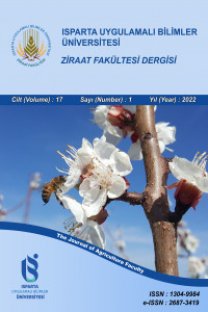Basınçlı Sulama Sistemlerinin COPAM Yazılımı ile Performans Analizi: Burdur Çavdır-Küçükalan Örneği
Bu çalışmada, Burdur Çavdır Küçükalan basınçlı sulama sisteminin performans analizini yapmak için COPAM (Sınıflandırılmış Karakteristik Eğriler Modeli) bilgisayar yazılımı kullanılmıştır. Bu yazılım yardımıyla debi – su kaynağı kotu, bağıl basınç açısından yetersiz hidrantların tespiti, hidrant güvenilirliği, farklı kaynak yüksekliklerinde hidrantların yeterliliği, mevcut koşullarda boru çaplarının yeninden belirlenmesi, hesaplanan boru çaplarına göre sulama sisteminin eski ve yeni maliyetinin karşılaştırılması gibi analizler yapılmıştır. Çalışma sonunda, sulama sisteminin mevcut koşullarda %90’lık bir verim ile çalışabileceği belirlenmiştir. Çalışmada ayrıca, sistemde bulunan 42 adet hidrantın 2’sinde hem bağıl basınç açısından yetersizlik olduğu hem de güvenilirlik değerlerinin -0- olduğu saptanmıştır. Mevcut koşullarda boru çapları açısından yapılan değerlendirmede ise 26 boru hattında (6 815.50 m) daha küçük çaplı borular kullanılması gerekirken 2 hatta (491.40 m) ise daha büyük çaplı boruların kullanılması gerektiği saptanmıştır. COPAM yazılımıyla hesaplanan boru çaplarının kullanılması durumunda, bağıl basınç eksikliği olan hidrant sayısı 1’e düşmüştür. Yapılan maliyet analizinde ise COPAM yazılımı ile belirlenen boru çaplarının kullanılması durumunda proje maliyetinden 57 262.49 $ tasarruf edilebileceği saptanmıştır. Sonuç olarak, basınçlı sulama sistemlerinin performans analizinde COPAM programının kullanılabileceği sonucuna ulaşılmıştır. COPAM veya benzeri programların kullanılması durumunda, projelerin yatırım maliyetlerini düşürerek verimliliklerini yükseltmek mümkün olabilecektir. Bu nedenle COPAM veya benzeri programların basınçlı sulama sistemlerinin değerlendirilmesi amacıyla ilgili kurumlar tarafından kullanılması gerektiği düşünülmektedir.
Anahtar Kelimeler:
Burdur, Güvenilirlik, Hidrant analizi, Sulama sistemi maliyet analizi, Sulama sistem performansı
Performance Analysis of Pressurized Irrigation Systems with COPAM Software: A Case of Burdur-Çavdır-Küçükalan
In this study, COPAM (Classified Characteristic Curves Model) computer software was used to analyze the performance of the Burdur Çavdır Küçükalan pressurized irrigation system. With the help of COPAM, analyses such as flow rate – water source elevation, detection of hydrants insufficient in terms of relative pressure, hydrant dependability, the sufficiency of hydrants at different water source elevations, re-calculation of pipe diameters in current conditions, comparison of old and new cost of the irrigation system according to calculated pipe diameters were made. At the end of the study, it was determined that the irrigation system could work with an efficiency of 90 % under current conditions. In the study, it was also determined that 2 of the 42 hydrants in the system were insufficient in terms of relative pressure and their reliability values were -0-. In the evaluation made in terms of pipe diameters under current conditions, it was determined that while smaller diameter pipes should be used in 26 pipelines (6 818.50 m), larger diameter pipes should be used in 2 pipelines (491.40 m). In the case of using pipe diameters calculated with COPAM, hydrants numbers with relative pressure deficiency decreased to 1. In the cost analysis, it was determined that if the pipe diameters determined by the COPAM are used, 57 262.49 $ can be saved from the project cost. As a result, it has been concluded that the COPAM can be used in the performance analysis of pressurized irrigation systems. If COPAM or similar programs are used, it will be possible to increase the efficiency of the projects by reducing their investment costs. For this reason, it is thought that COPAM or similar programs should be used by relevant institutions for the evaluation of pressurized irrigation systems.
Keywords:
Burdur, Dependability, Hydrant analysis, Irrigation system cost analysis, Irrigation system performance,
___
- Akyol, A. (2012). Basınçlı Sulama Şebekesinde Proje Debisi Hesaplamasına İlişkin Yöntem Karşılaştırması. (Yüksek Lisans Tezi, Ege Üniversitesi Fen Bilimleri Enstitüsü)
- Anonim, (2020). Burdur Meteorolojik Parametreleri. https://www.mgm.gov.tr/veridegerlendirme/il-ve-ilceler istatistik.aspx?m=BURDUR (Son erişim tarihi: 01.10.2020)
- Bethery, J. (1990). Réseaux Collectifs D'irrigation Ramifiés Sous Pression Calcul Et Fonctionnement. CEMAGREF Études. Clément, R. (1966). Calcul des débits dans les réseaux d'irrigation fonctionnant à la demande. La Houille Blanche, 5, 553-575. doi:10.1051/lhb/1966034
- CTGREF, (1979). Programme ICARE—Calcul des Caractéristiques Indicées. Note Technique 6, CTGREF Division Irrigation, Aix-en-Provence.
- DSİ, (2010). DSİ 18. Bölge Müdürlüğü Burdur Çavdır Küçükalan Göleti Planlama Raporu.
- Estrada, C., Gonzalez, C., Aliod, R., & Pano, J. (2009). Improved pressurized pipe network hydraulic solver for applications in irrigation systems. Journal of Irrigation and Drainage Engineering, 135(4), 421-430.
- Fouial, A., Khadra, R., Daccache, A., & Lamaddalena, N. (2016). Modelling the impact of climate change on pressurised irrigation distribution systems: use of a new tool for adaptation strategy implementation. Biosystems engineering, 150, 182–190. doi:10.1016/j.biosystemseng.2016.08.010
- Kara, M. (2005). Sulama ve Sulama Tesisleri. Selçuk Üniversitesi Basımevi, Konya.
- Kurtulmuş, E., Büyükcangaz, H., Kuşcu, H. & Demir, A. (2018). The hydraulic and economic performance analysis of on-demand pressurized irrigation systems: a case study in Turkey. Journal of Agricultural Sciences, 24(1), 42-49.
- Labye, Y., Olson, M.A., Galand, A., & Tsiourtis, N. (1988). Design and optimization of irrigation distribution networks. FAO Irrigation and Drainage Paper, No: 44, Rome, 1988.
- Lamaddalena, N. (1997). Integrated Simulation Modeling for Design and Performance Analysis of On-Demand Pressurized Irrigation Systems. (Ph.D, Dissertation, Technical University of Lisbon)
- Lamaddelena, N., & Sagardoy, J.A. (2000) Performance Analysis of on Demand Pressurized Irrigation Systems. FAO Irrigation and Drainage Paper, No: 59, Rome, 2000.
- Rossman, L. (2000). Epanet 2 User’s Manual. United States Environmental Protection Agency.
- Stefopoulou, A. & Dercas, N. (2017). NIREUS: A new software for the analysis of on-demand pressurized collective irrigation networks. Computers and Electronics in Agriculture, 140, 58-69.
- ISSN: 1304-9984
- Yayın Aralığı: Yılda 2 Sayı
- Başlangıç: 2006
- Yayıncı: Isparta Uygulamalı Bilimler Üniversitesi
Sayıdaki Diğer Makaleler
İlknur YURDAKUL, Kadriye KALINBACAK, Dilek ALTINKAYNAK, Remzi Murat PEKER
Türkiye’de Sığır Eti Üretiminin ARIMA (Box-Jenkins) Modeli ile Öngörüsü
Aslı DALGIÇ, Deniz SARICA, Vecdi DEMİRCAN
Bazı Beef Tipi Domates Hatlarının Morfolojik Özelliklerinin Belirlenmesi
Firooz Ahmad NIKZAD, Hasan BAYDAR
Basınçlı Sulama Sistemlerinin COPAM Yazılımı ile Performans Analizi: Burdur Çavdır-Küçükalan Örneği
Caner YALMANLI, Sabri ERBAŞ, Murat MUTLUCAN
Domateste Kök Ur Nematodu Mücadelesinde Kitosanın Toprak ve Yaprak Uygulamaları
Fatma Gül GÖZE ÖZDEMİR, Tuğçe ÖZEK, Jean Claude NDAYIRAGIJE, Hacer ÇEVİK, İsmail KARACA
